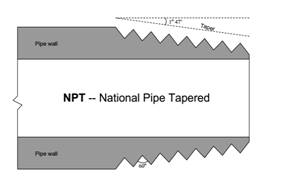This flow meter is named
so as it measures flow by counting the rotation of a turbine that is positioned
in the flow line. The fluid flowing through the pipe makes the blades of turbine
rotate at a speed that is proportional to the flow velocity of the fluid. The number of revolutions is monitored by either a gear
train or by a magnetic or optical pick-up.
The reader or a
“pick-up” is installed perpendicular to the rotor. Two types of pick-up
assemblies are commonly used: magnetic pick-up and no drag pick-up.
The magnetic pick-up
consists of a permanent magnet with a coil wrapped around the magnet. When the
turbine blades cut through the magnetic field, an alternating current, the
frequency of which is proportional to the flow, is induced in the coil.
Every turbine flow
meter is characterized by the K-factor,
a coefficient that for a specific flow of a particular fluid shows how many
pulses per liter are generated by the flow meter.
The K-factor can be calculated from:
K = 60*f/Qv
where
QV à the flow [liter/minute]
f à
frequency [pulse/s]
Kà K-factor [pulse/liter].
Ideally, the
value of K-factor should be constant i.e. relationship between the meter output
and the flow rate should be linear. In reality, however, the driving torque of
the fluid on the blade is
balanced by the influence of viscous, frictional and magnetic drag effects.
balanced by the influence of viscous, frictional and magnetic drag effects.
Since these
vary with the flow rate, the shape of the K-factor curve depends on
viscosity, flow rate, bearing design, blade edge sharpness, blade roughness and the nature of
the flow profile at the turbine leading edge. In practice, all these influences have differing
effects on the meter linearity and thus all turbine meters, even from the same manufacturing
batch, should be individually calibrated.
viscosity, flow rate, bearing design, blade edge sharpness, blade roughness and the nature of
the flow profile at the turbine leading edge. In practice, all these influences have differing
effects on the meter linearity and thus all turbine meters, even from the same manufacturing
batch, should be individually calibrated.
The linear
relationship of the K-factor is confined to a flow range of about 10:1 –
sometimes
extending up to 20:1.
At low
flows, the poor response of the meter is due to turbine rotor bearing friction,
the effect of fluid viscosity and magnetic drag on the rotor due to the use of
a magnetic pick-up. The humping section of the curve flattens as the viscosity
decreases – with resultant increase in accuracy.extending up to 20:1.
Practical
installation
-The turbine flow meter
requires equalization pipes at upstream and downstream sides of the instrument.
The length of the horizontal pipe segment on both sides depends on the flow
conditions. As a rule of thumb equalization pipe of 10D upstream and one of 5D
downstream is recommended.
– The accuracy of the
instrument is strongly influenced by the quality of the blades and the friction
of the rotor against its axis.
– Inertia of the rotor
can greatly influence the response time, especially when dealing with gases.
– To perform the digital-to-analog conversion, a frequency-to-voltage converter can be used, which transforms the pulses into a standard electrical signal.
– To perform the digital-to-analog conversion, a frequency-to-voltage converter can be used, which transforms the pulses into a standard electrical signal.
– To stop any contamination
that might block the turbine, a filter can be placed in front of the turbine
flow meter if desired.
– Providing a bypass is
efficient for continuous processes as it allows the replacement and cleaning of
the flow meter (and of the filter) without interrupting the process.
Characteristics
Advantages
-
An extensive selection of
ranges is available, for gases as well as for liquids.
-
A high level of accuracy,
(0.2-0.3%), is attainable under specific circumstances because of the digital
output.
-
Excellent repeatability (±
0.05 %).
-
Wide rangeability up to 20:1
-
Wide range of temperature
applications from -220 to 600 °C
-
Measurement of
non-conductive liquids.
-
Suitable for very low flow
rates.
Disadvantages
-
Very sensitive to wear,
especially with highly contaminated fluids and at high speeds.
-
Linear only in a limited
area, which reduces the measuring range.
-
Not suitable for high viscous
fluids.
-
Viscosity must be known.
-
10 diameter upstream and 5
diameters downstream of straight pipe is required.
-
Not effective with swirling
fluids.
-
Only suitable for clean
liquids and gases.
-
Relatively expensive.

























